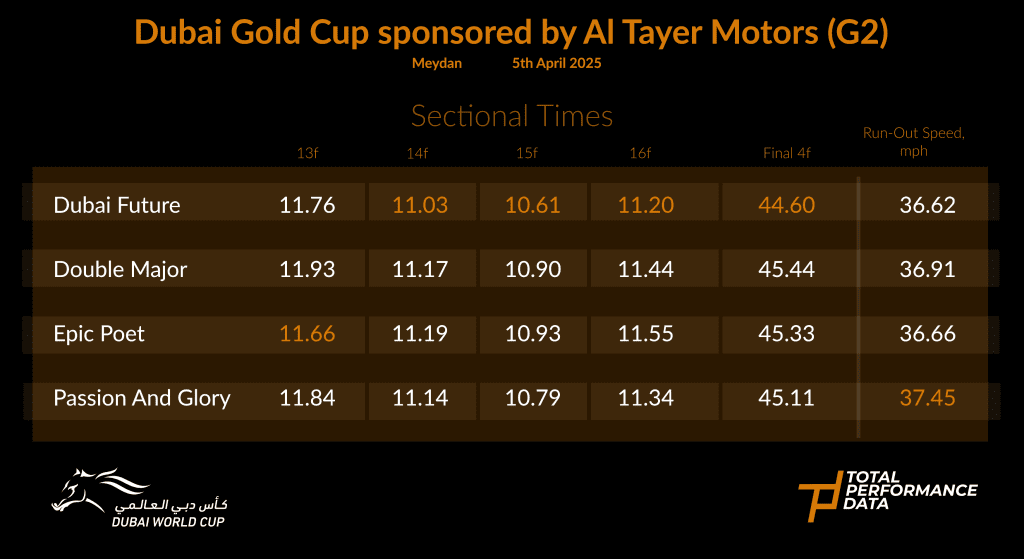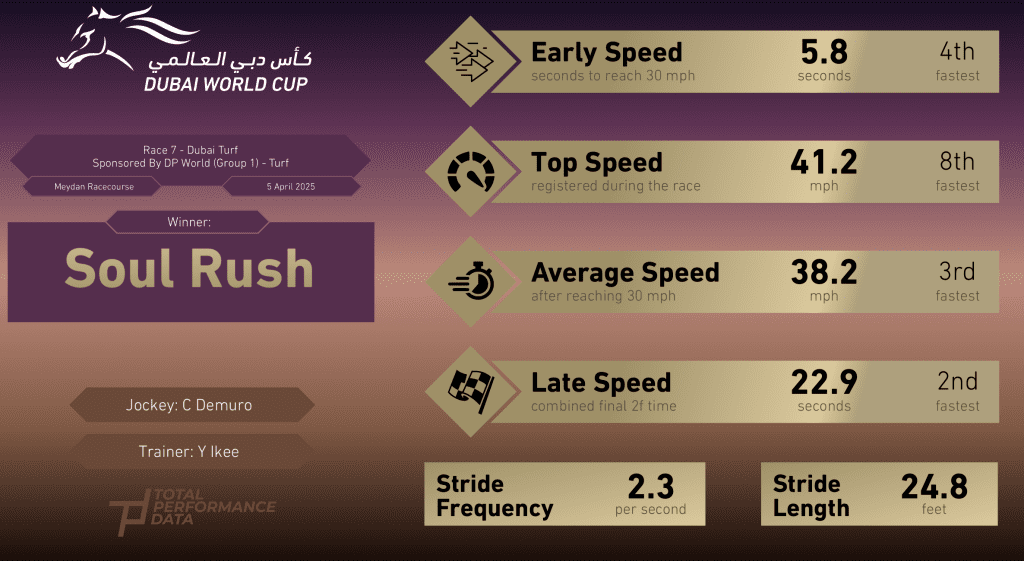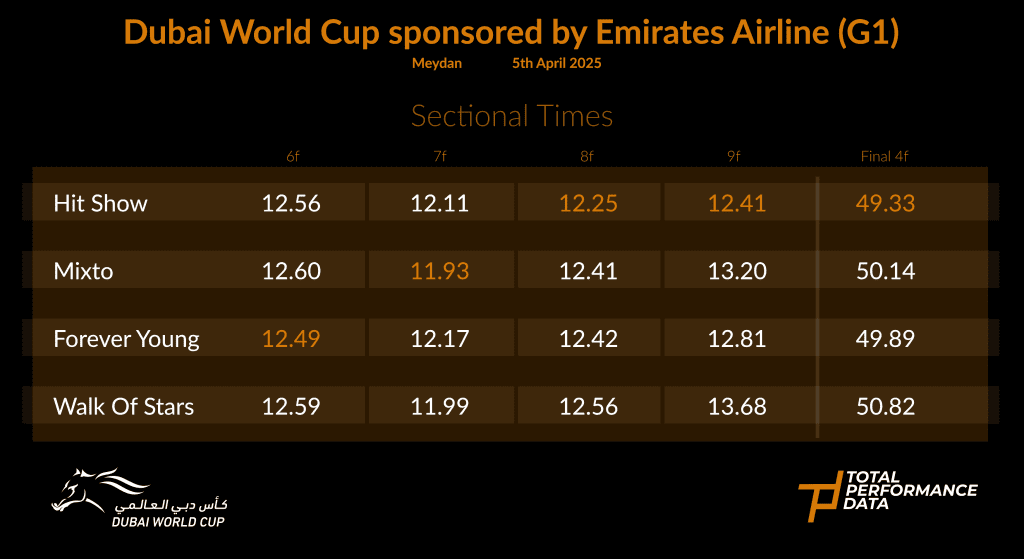It was a night of upsets at Meydan for this year’s Dubai World Cup. Each of the winners were the best horse on the night, but there are plenty of clues in the data from TPD to explain why they were victorious. Here’s a look at some of the highlights.
Dubai Gold Cup sponsored by Al Tayer Motors (Group 2)


It is a rare occurrence to see a race run over 2-miles where the winner runs a 10.61s furlong in the home straight, but that’s precisely what happened when Dubai Future rolled back the years to win this race. This race was run at a relative crawl. The early leader, Trawlerman, took 156.28s to reach the 4-furlong pole and with the running order barely changing, it was perhaps not a surprise to see this race won by a horse with form over shorter trips. To be fair to the runners in this race, all 10 of them have managed to record a top speed above 40 mph, but once he was switched wide under Silvestre de Sousa, Dubai Future had far too much speed for his rivals. He finished in 11.03, 10.61 and 11.20s, each of which was the fastest individual furlong in the field, recording the fastest speed at 42.50 mph.
To add some context to this sprint finish, Dubai Future finished in 32.84s for the final 3-furlongs, just 0.43s slower than the 32.41s recorded by Believing in the final 3-furlongs of the Al Quoz sprint. Trawlerman was ultimately outpaced, but the runner-up, Double Major, has stuck on well to hold 2nd place. The race had a finishing speed of 111%, which suited his prominent ride and the fact that he ran in a similar contest at Chantilly in his preparation for this (9th March 2025, finishing speed 114.3%) may well have helped him to quicken from the front. There will be lots of similar opportunities for him throughout the season in France and although his track position has certainly played a part in his success here, his top speed figure of 42.10 mph was only surpassed by the winner.
Dubai Future is a 9-year-old who has been around since 2019, so it would be hard to make the case that he is improving. However, he has won both starts so far this year since returning from an absence over 14-months and he has clocked the fastest top speed on both occasions. This race was run to suit, but he has had to overcome a poor position in order to win and was a clear best on the day. His peak stride length of 24.05 ft was ranked 8th in this field, but he quickened better than any of his rivals, with a top ranked peak stride frequency of 2.51 per second. He hasn’t run in the UK since 2022, but if he were to be brought here for a summer campaign, there should be other opportunities for him.
Godolphin can also take some comfort from the performance of Passion and Glory who finished 4th. Having raced alongside the winner, he was no match for Dubai Future when the pace lifted, but he has finished his race in 10.79 and 11.34s, a time only surpassed by the winner and with the better run-out speed at 37.45 mph, he has run a solid race in circumstances that didn’t suit.
Dubai Turf sponsored by DP World (Group 1)


Did the Saudi Cup leave a mark on Romantic Warrior? Quite possibly. He was awash with sweat at the start and looked uncomfortable as he stood behind the stalls. He broke with his usual speed, taking 5.8s to reach 30 mph and at halfway, James MacDonald must have been relatively happy with his position behind the leader. Moving forwards around the turn, he ran 11.95s for the 6th furlong and hit the front as the field straightened up. However, once in front he began to struggle and the eventual winner, Soul Rush, was faster than him over each of the final 3-furlongs. At no point in this race did Romantic Warrior run the fastest individual furlong and his final furlong time of 11.97s was only the 7th fastest time in the field. That is in stark contrast to his victory in the Jebel Hatta in January when he ran the fastest split for 4 of the last 5-furlongs to win by 4-lengths. It may well be a combination of sweating up at the start and the hard race with Forever Young in Riyadh, but Romantic Warrior didn’t quite match the form levels that we have come to expect, although he has still produced a top class performance.
A lot of focus will be given to the performance of the beaten favourite, but that should not detract from an excellent display from Soul Rush. He had some very solid form in the book from Hong Kong and Japan coming into this race and had to battle for racing room in the home straight to get a run on Romantic Warrior in the closing stages. Once in the clear, he took 0.37s out of Romantic Warrior in the final quarter of a mile to get his nose in front on the line.
The first 2 had the best form in this race, but the horse to take from it is surely the 3rd placed Maljoom. He ran below par when beaten at Lingfield in February in his preparation for this, but he took a huge step forward here. Further back than ideal, Tom Marquand has driven his mount through the field to finish a “never-nearer” 3rd, beaten just over a length. Over the final 3-furlongs, he finished 0.28s faster than the winner and he recorded the best run-out speed in the field at 37.49 mph. He was ridden to come with a late run and that needs to be allowed for, but he has flown from the 2-furlong pole and should be capable of being competitive in Group 1 company when he returns to Europe if he remains in the same form.
Longines Dubai Sheema Classic (Group 1)


Oh Calandagan! I’ve written about this horse on many occasions in the last 12-months and I remain convinced that he will get the Group 1 success that he deserves, but yet again he has lost his race at the start. He took 6.6s to reach 30 mph from the gate and ran 15.75s for the opening furlong (ranked 6th of 9). For comparison, the winner, Danon Decile took 6s to reach 30 mph and ran 15.32s to the first furlong pole. It’s a small margin, but in a race won by 0.19s with a more prominent track position, it made all the difference. Trapped towards the rear on the inside rail, Mickael Barzalona has had to sit and wait for the gaps to come. To Calandagan’s enormous credit, he has finished in 10.83, 10.47 and 10.98s, each of which were the fastest furlongs in the field and his run-out speed of 38.74 mph was a clear best in this race. However, given the ground lost at the start, he has once again left himself with too much to do in the closing stages. At some point in 2025, possibly in France, he will find a Group 1 race where the pace is slack enough for him to make up any ground lost at the start at an earlier stage, but the data doesn’t lie and he will always be vulnerable at the highest level because of the way he breaks from the gate.
Calandagan was probably the best horse in this race, but Danon Decile proved himself to be a top class international performer here and his effort should not be underestimated. At 43.40 mph, he matched the top speed figure recorded by Calandagan and as we can see from the sectional times above, he ran 10.51s for the penultimate furlong to put this race to bed. Already a Japanese Derby winner, he has taken his first step on to the International stage in his stride and if his connections were so inclined, he could be a horse to finally break the Japanese “duck” in the Prix de L’Arc de Triomphe if the conditions were in his favour.
Dubai World Cup sponsored by Emirates Airline (Group 1)


If the Saudi Cup left a mark on Romantic Warrior then it surely did the same to Forever Young. His average stride length (24.34 ft) and his average stride frequency (2.26 per second) were lower than he recorded in Riyadh, albeit on a less abrasive dirt surface. He had to be driven from the gate to get into a prominent position and struggled to hold that position in the back straight and lost 0.37s on Mixto in furlongs 3 and 4. He was outpaced around the home turn and to his credit, he battled on bravely, running 12.81s for the final furlong, a time only surpassed by the winner, but this was still a very flat performance. Like Romantic Warrior, at no point in this race was he able to run the fastest individual furlong and it is possible that this might have been one race too many after a very busy International campaign over the last 12-months. Given a break, there is no reason to think that he won’t be able to compete at the highest level on the dirt later in the year.
I’ll spare a thought for Mixto, who has run a fine race under Frankie Dettori and was very unlucky to be chinned in the final strides. This race had a finishing speed of 98.7%. Given that he led most of the way and readily saw off his main rival for the lead, the eventual 4th, Walk of Stars, he has run a remarkable race. When he ran the fastest 7th furlong in 11.93s, Dettori must have thought that he had won the race, but the fuel gauge was about to flash red and Mixto didn’t quite make it home. Both his average stride frequency (2.21 per second) and his average stride length (6.85m) dropped to a race low in the final furlong. He saw out his race in 13.20s, 0.79s slower than the winner and it looks likely that he has paid the price for exerting more energy than most in the early stages.
Hit Show has won 9 of his 18 career starts, but his International SP of 80/1 would look to reflect his chance of winning at the start based on the form that he has shown in the US. He was soundly beaten by Locked at Santa Anita in March, but produced a career best display to win this year’s World Cup, even if we have to allow for the fact that he was ideally placed to pick up the pieces when the pace collapsed. As we can see from the sectional times above, he was slowing down in the final 2-furlongs, but he had more energy left than those in front of him and was able to see out his race well with the fastest run-out speed in the field (34.58 mph) to go with the fastest 8th and 9th furlong splits. Will he uphold this form? Probably not. He did exceptionally well to come through the field and run down Mixto in the closing stages, but I think that he was the beneficiary of the circumstances on the night and he may not be next time.
You can find sectional times, stride data, speed statistics and jumping performance metrics on the At The Races RESULTS page.
The global database of sectional times, stride data and performance metrics is available through Total Performance Data.